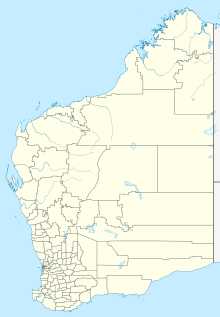The Pilbara is a large, dry, thinly populated region in the north of Western Australia. It is known for its Aboriginal peoples; its ancient landscapes; the red earth; and its vast mineral deposits, in particular iron ore. It is also a global biodiversity hotspot for subterranean fauna.

Fortescue is a global metal mining and green energy company headquartered in Australia. Fortescue focused on iron ore mining under the name of Fortescue Metals Group (FMG) until July 2023. As of 2017, Fortescue is the fourth-largest iron ore producer in the world. The company has holdings of more than 87,000 km2 in the Pilbara region of Western Australia, making it the largest tenement holder in the state, larger than both BHP and Rio Tinto.

The Goldsworthy railway, owned and operated by BHP, is a private rail network in the Pilbara region of Western Australia built to carry iron ore. It is one of two railway lines BHP operates in the Pilbara, the other being the Mount Newman railway.

The Fortescue railway, owned and operated by Fortescue Metals Group (FMG), is a private rail network in the Pilbara region of Western Australia built to carry iron ore. It opened in 2008. When it was completed, it was the heaviest haul railway in the world, designed for 40 tonne axle loads, 2.5 to 5 tonnes heavier than the other Pilbara iron ore rail systems. On 4 November 2014, FMG Rail commenced trialling 42-tonne axle loads.

The Mount Whaleback mine, officially the Newman West operation, is an iron ore mine located in the Pilbara region of Western Australia, six kilometres west of Newman.
The Christmas Creek mine is an iron ore mine located in the Pilbara region of Western Australia, 61 kilometres south-south-west of Nullagine, in the Chichester Range.

Iron ore mining in Western Australia, in the 2018–19 financial year, accounted for 54 percent of the total value of the state's resource production, with a value of A$78.2 billion. The overall value of the minerals and petroleum industry in Western Australia was A$145 billion in 2018–19, a 26 percent increase on the previous financial year.
The Area C mine is an iron ore mine located in the Pilbara region of Western Australia, 92 kilometres west-north-west of Newman.
The Jimblebar mine is an iron ore mine located in the Pilbara region of Western Australia, 41 kilometres east of Newman.
The Pardoo mine was an iron ore mine located in the Pilbara region of Western Australia, 75 kilometres east of Port Hedland.
The Wodgina mine is an exhausted iron ore mine located in the Pilbara region of Western Australia, 90 kilometres south of Port Hedland.
The Yarrie mine is an iron ore mine located in the Pilbara region of Western Australia, 90 kilometres north-east of Marble Bar.

The Yandi mine is an iron ore mine located in the Pilbara region of Western Australia, 90 kilometres north-west of Newman. It should not be confused with Rio Tinto's nearby Yandicoogina mine, which is also sometimes shortened to Yandi.
The Orebodies 18, 23 and 25 mine, part of BHP's Eastern Ridge hub and officially referred to as the Newman East operation, is an iron ore mine located in the Pilbara region of Western Australia, 8 kilometres east of Newman. The mine is majority-owned and operated by BHP, and is one of seven iron ore mines the company operates in the Pilbara. The company also operates two port facilities at Port Hedland, Nelson Point and Finucane Island, and over 1,000 kilometres of rail in the Pilbara.
The Iron Valley mine is a small iron ore mine located in the Pilbara region of Western Australia, 75 kilometres (47 mi) northwest of Newman, 270 kilometres (170 mi) south of Port Hedland, and 10 kilometres (6.2 mi) east of the Yandicoogina mine.
The Railways in the Pilbara are a collection of railways in the Pilbara region of north-west Western Australia.
The Miralga Creek mine is an iron ore mine operated by Atlas Iron and located in the Pilbara region of Western Australia, 100 kilometres (62 mi) south-east from Port Hedland. Ore from the mine is transported overland via road train to the Utah Point Bulk Commodities Berth at Port Hedland.
The Eliwana mine is an iron ore mine operated by the Fortescue Metals Group (FMG) and located in the Pilbara region of Western Australia, 90 kilometres west of Tom Price. The mine forms the core of the company's Western Hub, one of three of its active mining areas, together with the Chichester Hub and the Solomon Hub.

The Firetail mine is an iron ore mine operated by the Fortescue Metals Group (FMG) and located in the Pilbara region of Western Australia, 60 km (37 mi) north of Tom Price. The mine is part of the company's Solomon Hub, one of three of its active mining areas, together with the Chichester Hub and the Western Hub.

The Kings Valley mine is an iron ore mine operated by the Fortescue Metals Group (FMG) and located in the Pilbara region of Western Australia, 60 km (37 mi) north of Tom Price. The mine, along with Firetail mine, is part of the company's Solomon Hub, one of three FMG's mining areas, the others being the Chichester Hub and the Western Hub.











